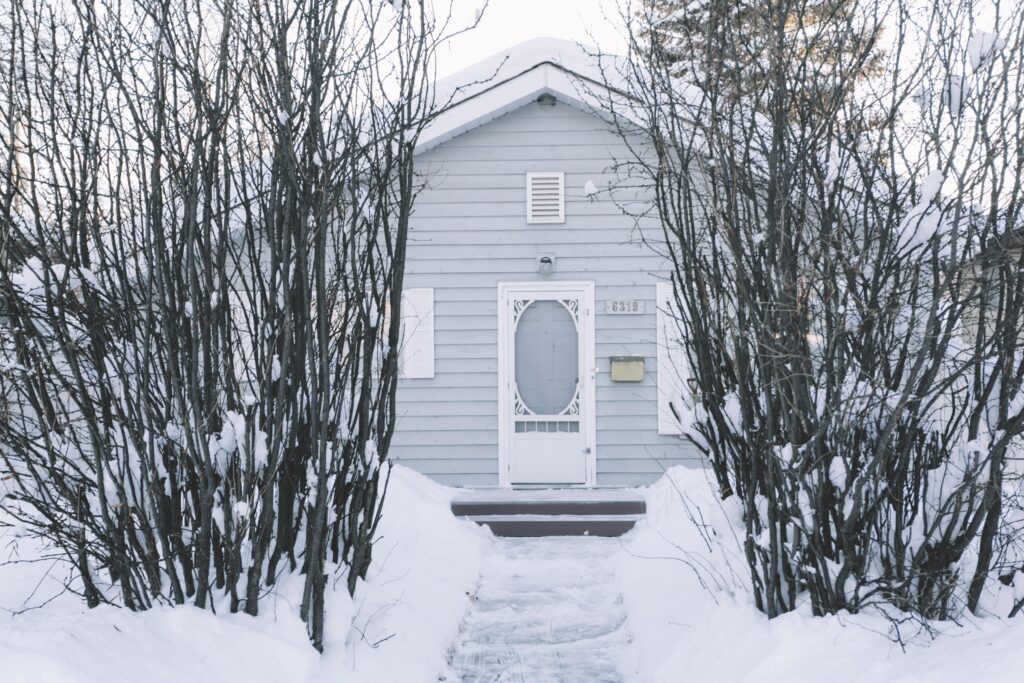Winter can present a range of challenges for mobile homeowners. The cold weather creates unique risks, such as drafts, frozen pipes, and keeping heating costs in check. However, with the right preparation, you can protect your home and stay cozy all season long. Proactive winterization keeps your space warm and secure and prevents costly damage, no matter how harsh the weather gets.
Below, we’ll walk you through everything you need to know regarding how to winterize a mobile home. You will also learn essential money-saving tips to stay within your project budget.
Mobile Home Vulnerabilities in Winter
Due to their construction and design, mobile homes are especially vulnerable to winter-related issues. Older models often lack adequate insulation, leading to higher heating costs and cold drafts.
The undersides of mobile homes are also exposed to the elements, making pipes susceptible to freezing. Without proper preparation, mobile homes can experience significant damage during harsh winters, from water damage caused by burst pipes to roof problems caused by snow accumulation.
How to Winterize a Mobile Home: Essential Steps
Winterizing your mobile home requires careful planning and attention to key areas vulnerable to cold weather. Certain areas like plumbing and insulation require a homeowner’s attention as they can impact your property’s long-term value.
Insulating Your Mobile Home
One of the most critical aspects of winterizing your home is insulation. Start by adding insulation to the walls, floors, and ceilings. Insulated skirting can also help protect the underside of your home, keeping pipes and floors warmer. Seal any gaps or leaks in doors and windows with caulking or weather stripping, and consider adding storm windows or heavy curtains for extra insulation.
Protecting Pipes from Freezing
Frozen pipes are a common and costly issue in mobile homes during winter. Use heat tape or pipe insulation to wrap all exposed pipes, especially those underneath your home. Ensure outdoor hoses are disconnected, and cover spigots with insulated covers. If temperatures drop significantly, consider draining the pipes to prevent freezing and bursting.
Inspecting and Maintaining Your HVAC System
Your heating system will work overtime in the winter, so ensuring it’s in good condition is essential. Replace or clean furnace filters and schedule a professional inspection to check for issues. In case of emergencies, consider investing in a backup heat source, such as a portable electric heater.
Sealing Air Leaks
Air leaks are a major cause of heat loss in mobile homes. Identify drafty areas around vents, doors, and windows and seal them with caulking or foam insulation. Install door sweeps or draft stoppers at the base of exterior doors to block cold air from seeping in.
Roof and Gutter Maintenance
A leaky or weak roof can cause significant problems during winter. Inspect your roof for cracks, loose shingles, or leaks, and make any necessary repairs. Clear gutters of leaves and debris to prevent ice buildup, and use a roof rake to remove heavy snow that could compromise your roof’s integrity.
Foundation and Skirting Upkeep
Your mobile home’s skirting is vital in maintaining warmth and protecting the foundation. Inspect the skirting for cracks, holes, or gaps and repair any damage. Reinforce the foundation to prevent shifting caused by freezing and thawing cycles.
Energy-Efficiency Upgrades
Improving your mobile home’s energy efficiency keeps you warm and lowers heating costs. Consider installing a programmable thermostat for better temperature control and energy savings. Reflective insulation for ceilings can also help retain heat. Upgrade to energy-efficient heaters and appliances to maximize cost savings during the colder months.
Safety Measures During Winter
Keeping your home safe during winter is just as important as staying warm. Here are some safety measures you can take to protect your household from common cold-weather hazards.
Preventing Ice Dams and Roof Collapse
Proper roof ventilation is key to preventing ice dams. Keep your roof clear of heavy snow to avoid excess weight that could cause a collapse. Use roof rakes or hire professionals for safe snow removal.
Avoiding Carbon Monoxide Poisoning
Ensure all heating appliances function properly and are vented properly to prevent carbon monoxide buildup. Install carbon monoxide detectors in key areas of your home and test them regularly.
Fire Safety Tips
Space heaters can be a fire hazard if used improperly. Keep them away from flammable materials, and never leave them unattended. Test smoke detectors to ensure they’re operational, and keep a fire extinguisher on hand.
Common Winterization Mistakes to Avoid
Many mobile homeowners overlook critical steps as they learn how to winterize a manufactured home. These mistakes can lead to inefficiencies, costly repairs, and unsafe conditions. Here are the most common mistakes and how to avoid them:
- Failing to Inspect and Repair Skirting: Skirting insulates the underside of your home and blocks cold air. Check for cracks or gaps and repair them to avoid frozen pipes and higher heating costs.
- Using the Wrong Materials for Pipe Insulation: Low-quality insulation leaves pipes vulnerable to freezing. To protect pipes, use heat tape or specialized insulation for cold climates. Always order high-quality materials for all repair and maintenance jobs.
- Neglecting Small Air Leaks: Gaps around windows, doors, and vents cause heat loss and higher energy bills. Seal these leaks with caulking, weather stripping, or foam.
- Overlooking HVAC Maintenance: A neglected heating system can fail when needed most. Regularly replace filters and schedule inspections to maintain efficiency and reliability.
- Ignoring Roof and Gutter Maintenance: Snow and ice buildup can cause leaks and structural damage. Clear gutters and remove excess snow to prevent costly repairs.
- Skipping Foundation and Underbelly Inspections: Gaps in the foundation or underbelly allow cold air, risking frozen pipes. Inspect and address any damage promptly.
- Forgetting to Drain and Protect Outdoor Water Sources: Unprotected hoses and spigots can freeze and burst. Disconnect hoses and drain spigots and cover them with insulation.
- Relying Solely on Space Heaters: Space heaters are usually inefficient and can pose fire hazards. Use them sparingly and keep them away from flammable materials.
Mobile Home Winterization Checklist
Here’s a quick reference or summary checklist of tasks you need to perform to protect your mobile home during the winter, as discussed earlier:
- Insulate and Weatherproof: Reinforce insulation, seal doors/windows, and install storm windows.
- Protect Pipes: Wrap pipes, drain water lines, and cover outdoor faucets.
- HVAC Maintenance: Clean filters, schedule an inspection, and secure a backup heat source.
- Seal Air Leaks: Use caulking, foam insulation, and door sweeps.
- Roof and Gutter Care: Repair leaks, clear gutters, and remove snow/ice.
- Foundation and Skirting: Inspect and repair the skirting and reinforce the foundation.
- Safety Precautions: Install detectors, test appliances, and maintain fire safety.
Estimated Costs of Winterizing a Mobile Home
Winterization costs can vary depending on your mobile home’s size and condition. Insulating walls and skirting may cost between $500 and $2,000, while pipe protection materials are inexpensive. HVAC inspections typically range from $75 to $150.
Note that these are only estimates, and the actual cost will vary depending on your location. Working with professional services can help you get accurate quotes and ensure the job is done efficiently.
Winterize Your Mobile Home with High-Quality Materials
Winterizing your mobile home is essential for maintaining comfort, safety, and energy efficiency during the colder months. Following the steps in this guide and using high-quality materials can protect your home from winter hazards and lower your energy bills. For reliable supplies, including skirting, insulation, and plumbing solutions, trust Basic Components as your go-to provider.
Visit Basic Components to find everything you need for a worry-free winter.
Contact our team today if you need help finding the necessary tools and materials.


